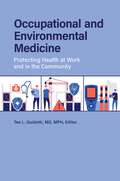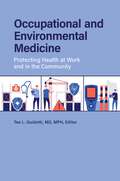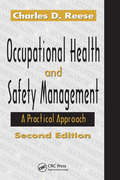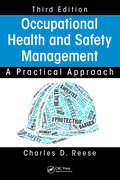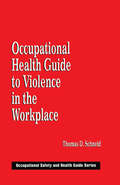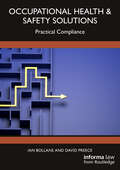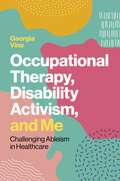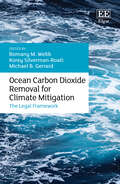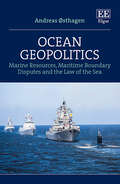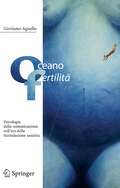- Table View
- List View
The Occupation of Justice: The Supreme Court of Israel and the Occupied Territories
by Yaël Ronen David KretzmerJudicial review by Israel's Supreme Court over actions of Israeli authorities in the territories occupied by Israel in 1967 is an important element in Israel's legal and political control of these territories. The Occupation of Justice presents a comprehensive discussion of the Court's decisions in exercising this review. This revised and expanded edition includes updated material and analysis, as well as new chapters. Inter alia, it addresses the Court's approach to its jurisdiction to consider petitions from residents of the Occupied Territories; justiciability of sensitive political issues; application and interpretation of the international law of belligerent occupation in general, and the Fourth Geneva Convention in particular; the relevance of international human rights law and Israeli constitutional law; the rights of Gaza residents after the withdrawal of Israeli forces and settlements from the area; Israeli settlements and settlers; construction of the separation barrier in the West Bank; security measures, including internment, interrogation practices, and punitive house demolitions; and judicial review of hostilities. The study examines the inherent tension involved in judicial review over the actions of authorities in a territory in which the inhabitants are not part of the political community the Court belongs to. It argues that this tension is aggravated in the context of the West Bank by the glaring disparity between the norms of belligerent occupation and the Israeli government's policies. The study shows that while the Court's review has enabled many individuals to receive a remedy, it has largely served to legitimise government policies and practices in the Occupied Territories.
Occupational and Environmental Medicine: Protecting Health at Work and in the Community
by Tee L. GuidottiProviding a concise introduction to the field of occupational and environmental medicine, this book delves into what it does, how it protects workers, how it benefits employers, and how it is developing as an important field in health protection.This book shines a light on an important but little-appreciated corner of medicine where health, technology, the environment, and the economy come together to have a real impact on people and society. The text serves as one of the few entry points into the world of occupational and environmental health protection for readers interested in learning more about it and what it can do for them.Readers will be introduced to such topics as the history of occupational and environmental medicine (OEM), schools of thought associated with OEM, the relationship of OEM to neighboring fields of study, and profiles of OEM practitioners. This guide emphasizes the rich potential for environmental medicine to contribute to sustainability, public health, and community health protection, making it an essential resource for anyone interested or involved in these sectors.
Occupational and Environmental Medicine: Protecting Health at Work and in the Community
Providing a concise introduction to the field of occupational and environmental medicine, this book delves into what it does, how it protects workers, how it benefits employers, and how it is developing as an important field in health protection.This book shines a light on an important but little-appreciated corner of medicine where health, technology, the environment, and the economy come together to have a real impact on people and society. The text serves as one of the few entry points into the world of occupational and environmental health protection for readers interested in learning more about it and what it can do for them.Readers will be introduced to such topics as the history of occupational and environmental medicine (OEM), schools of thought associated with OEM, the relationship of OEM to neighboring fields of study, and profiles of OEM practitioners. This guide emphasizes the rich potential for environmental medicine to contribute to sustainability, public health, and community health protection, making it an essential resource for anyone interested or involved in these sectors.
Occupational Health and Safety Management: A Practical Approach, Second Edition
by Charles D. ReeseDeveloped to provide safety and health students with an understanding of the how-tos of implementing an occupational safety and health initiative, the first edition of Occupational Health and Safety Management soon became a blueprint for occupational safety and health management for the smallest- to the largest-sized companies. Competently followin
Occupational Health and Safety Management: A Practical Approach, Third Edition
by Charles D. ReeseReflecting changes in the current health and safety landscape, Occupational Health and Safety Management: A Practical Approach, Third Edition includes examples and tools to facilitate development and implementation of a safety and health management approach. This how-to book is not just an information providing text. It shows you how to write a program and identify hazards as well as involve workers and attain their cooperation. It emphasizes the need for better and more effective communication regarding safety and health. See What’s New in the Third Edition: Chapters on workers’ compensation, terrorism, and Lean safety/sustainability Additional coverage of flammable liquids and ventilation, accident reporting, and accident investigation New compliance requirements as well as expanded accident investigation, environmental, and risk analysis guidelines PowerPoint presentation slides for each chapter A complete and practical guide for the development and management of occupational safety and health programs in any industry setting, the book supplies a management blueprint that can be used for occupational safety and health in any organization, from the smallest to the largest, beginning to develop or wanting to improve its safety and health approach. It includes comprehensive guidelines for development of occupational health and safety programs to a variety of industries and is especially useful for start-up companies. The author takes a total management approach to the development of written programs, the identification of hazards, the mitigation of hazards by the use of common safety and health tools, the development of a safe workforce through communications, motivational techniques, involvement, and training. He addresses the tracking and acceptable risk from both safety and health hazards. He also discusses how to work with and within the OSHA compliance approach as well as how to deal with the OSHA regulations, workers’ compensation, terrorism, and Lean safety. As you understand and apply the guidelines in each chapter, you can put your company on the way toward building a successful and effective safety and health effort for its employers and employees.
Occupational Health Ethics: From Theory to Practice
by Jacques TaminThis book provides occupational health (OH) professionals with a theoretical basis for addressing the ethical issues that they confront in their practice. There is often a lack of in-depth moral analysis of the issues that OH practitioners face on a daily basis. The ICOH Code of Ethics sets out the important principles that guide OH practice. This book builds on these core principles, starting from an application of moral theories in the OH context and illustrating how ethical conflicts could be resolved, by carrying out ethical analyses of several case studies. In this way, it aims to link ethical theory to OH practice.
Occupational Health Guide to Violence in the Workplace
by Thomas D. Schneid20 murders every week. 18,000 assaults in the same time. All on the job.Sharp increases in workplace violence continue to take an unfortunate toll on American business-and its employees, families and communities. Preventative measures may be well-intentioned, but pose troubling conflicts in themselves, pitting each employee's privacy vs. overall worker protection.A full-self evaluation of your business and its personnel may be the key to safeguard against workplace violence. Thomas D. Schneid's Occupational Health Guide to Violence in the Workplace provides the important guidelines for that careful, all-encompassing examination.Most books on workplace violence focus on psychological profiles. In a change of pace, Schneid examines the issue from a safety/health professional's viewpoint, taking all angles, legal issues, and potential ramifications into account. Chapters focus on not only in-house efforts to prevent violent incidents, but also government and legal standards directly or indirectly related to worker's rights and corporate liability.Make every effort to prevent workplace violence from hitting home: start with advice from the Occupational Health Guide to Violence in the Workplace
Occupational Health Guide to Violence in the Workplace (Occupational Safety And Health Guide Ser. #2)
by Thomas D. Schneid20 murders every week. 18,000 assaults in the same time. All on the job.Sharp increases in workplace violence continue to take an unfortunate toll on American business-and its employees, families and communities. Preventative measures may be well-intentioned, but pose troubling conflicts in themselves, pitting each employee's privacy vs. overall worker protection.A full-self evaluation of your business and its personnel may be the key to safeguard against workplace violence. Thomas D. Schneid's Occupational Health Guide to Violence in the Workplace provides the important guidelines for that careful, all-encompassing examination.Most books on workplace violence focus on psychological profiles. In a change of pace, Schneid examines the issue from a safety/health professional's viewpoint, taking all angles, legal issues, and potential ramifications into account. Chapters focus on not only in-house efforts to prevent violent incidents, but also government and legal standards directly or indirectly related to worker's rights and corporate liability.Make every effort to prevent workplace violence from hitting home: start with advice from the Occupational Health Guide to Violence in the Workplace
Occupational Health Law
by Diana KlossKloss on 'Occupational Health Law' has become the standard reference work on the subject since it was first published in 1989. Detailed but highly readable, it provides an essential source of information for health professionals working in occupational health and also for human resources staff. In the years since the 4th edition was written there have been many changes in the field of occupational health, which has achieved a higher profile nationally with the publication of Dame Carol Black's review of the health of Britain's working age population in 2008. This edition, which has been fully revised, includes new sections on age discrimination and expert witnesses, and the sections on discrimination, especially disability discrimination, the Working Time Regulations, stress related illness, corporate manslaughter and confidentiality, in particular, have been substantially updated. The established work on the subject Fully revised in line with current legislation and case law Essential reference for occupational health, personnel and health and safety departments 'Essential reading... clear, straight to the point... superb value for money' —Occupational Safety and Health
Occupational Health Law
by Diana KlossA new edition has become needed because of the large number of changes in the law since the last edition was published in 1998. These include the Human Rights Act; the Data Protection Act 1998 which was brought into force in 2000; new case law on compensation (particularly with regard to stress); the Woolf reforms on civil procedures, especially regarding expert witnesses; and developments in equal opportunities law (e.g. maternity leave). The section on disability discrimination has been completely rewritten. Other new features include genetic testing in employment and the new offence of corporate manslaughter, and details regarding the new training and evaluation criteria that occupational health professionals are required to satisfy.
Occupational Health Law
by Diana KlossKloss on 'Occupational Health Law' has become the standard reference work on the subject since it was first published in 1989. Detailed but highly readable, it provides an essential source of information for health professionals working in occupational health and also for human resources staff. In the years since the 4th edition was written there have been many changes in the field of occupational health, which has achieved a higher profile nationally with the publication of Dame Carol Black's review of the health of Britain's working age population in 2008. This edition, which has been fully revised, includes new sections on age discrimination and expert witnesses, and the sections on discrimination, especially disability discrimination, the Working Time Regulations, stress related illness, corporate manslaughter and confidentiality, in particular, have been substantially updated. The established work on the subject Fully revised in line with current legislation and case law Essential reference for occupational health, personnel and health and safety departments 'Essential reading... clear, straight to the point... superb value for money' —Occupational Safety and Health
Occupational Health & Safety Solutions: Practical Compliance
by Ian Bollans David PreeceHealth and safety legislation places significant responsibilities on employers and managers to protect the health and safety of their workers, but the subject area is seen as both complex and technical in nature, often requiring the input of professionals. This book dispels these myths by taking a unique approach, allowing somebody with little or no knowledge of the subject to understand their legal duties and then take a practical step-by-step approach to control workplace risks and prevent accidents.Occupational Health & Safety Solutions: Practical Compliance is a reworking and updating of Jordan Publishing’s Health and Safety Management, published by LexisNexis from 1997 to 2023. The book takes a comprehensive approach by covering the main subject areas of occupational health and safety and is relevant to all types of workplaces. It provides enough background knowledge for the reader to understand what the law requires, and what needs to be done to achieve compliance, with the main emphasis being on practical application. Providing the reader with the ability to manage health and safety through a process of flowcharts, diagrams, and extensive checklists, the book draws on the expertise of the authors and current best practice within industry. Each chapter sets out a clear, practical approach to identifying and managing risks, thereby enabling a robust and successful health and safety management system to be established in any workplace.The book is written for non-safety professionals such as managers and directors who want to discharge and manage their health and safety responsibilities in their workplace without the need to engage a consultant. It will also appeal to the safety professional by providing an authoritative guide to current best practice together with the practicalities of managing health and safety risks.
Occupational Health & Safety Solutions: Practical Compliance
by Ian Bollans David PreeceHealth and safety legislation places significant responsibilities on employers and managers to protect the health and safety of their workers, but the subject area is seen as both complex and technical in nature, often requiring the input of professionals. This book dispels these myths by taking a unique approach, allowing somebody with little or no knowledge of the subject to understand their legal duties and then take a practical step-by-step approach to control workplace risks and prevent accidents.Occupational Health & Safety Solutions: Practical Compliance is a reworking and updating of Jordan Publishing’s Health and Safety Management, published by LexisNexis from 1997 to 2023. The book takes a comprehensive approach by covering the main subject areas of occupational health and safety and is relevant to all types of workplaces. It provides enough background knowledge for the reader to understand what the law requires, and what needs to be done to achieve compliance, with the main emphasis being on practical application. Providing the reader with the ability to manage health and safety through a process of flowcharts, diagrams, and extensive checklists, the book draws on the expertise of the authors and current best practice within industry. Each chapter sets out a clear, practical approach to identifying and managing risks, thereby enabling a robust and successful health and safety management system to be established in any workplace.The book is written for non-safety professionals such as managers and directors who want to discharge and manage their health and safety responsibilities in their workplace without the need to engage a consultant. It will also appeal to the safety professional by providing an authoritative guide to current best practice together with the practicalities of managing health and safety risks.
Occupational Therapy, Disability Activism, and Me: Challenging Ableism in Healthcare
by Georgia VineThis is a unique and important perspective on challenging ableism in healthcare from an author who is a service user, a disability activist, and an occupational therapist. Georgia Vine charts her life's journey and provides vital insight on how the education, health and social care systems need to be improved.
Occupiers' Liability
by Peter NorthOccupiers' liability is an area of tort law rich in statutory material and jurisprudence, having developed outside the framework of general negligence liability. It governs the duty of care which an occupier, landlord or builder owes to people who visit or trespass on their land. As the only text offering in depth analysis and commentary on the legislation and case law surrounding occupiers' liability, this book represents a key reference text for all those involved in advising on or researching this area. Each aspect of the law in this area is examined in detail, with the definitions of premises, occupiers, visitors, and trespassers analysed through a substantial body of case law. The types of harm which occupiers may be liable for and the available defences are also given detailed discussion. Further chapters are devoted to the specific provisions and precedents governing the scope of the statutory duty of care, liability of independent contractors, and the liability of occupiers to those who enter premises under contract. The text also covers the statutory regime and case law surrounding liability for defective premises under the Defective Premises Act 1972, which replaced provisions relating to this under the 1957 Occupiers' Liability Act. The book includes the full text of both the 1957 and the 1984 Occupiers' Liability Acts and of the Defective Premises Act 1972.
Occupy: Three Inquiries in Disobedience (TRIOS)
by W. J. Mitchell Bernard E. Harcourt Michael TaussigMic check! Mic check! Lacking amplification in Zuccotti Park, Occupy Wall Street protestors addressed one another by repeating and echoing speeches throughout the crowd. In Occupy, W. J. T. Mitchell, Bernard E. Harcourt, and Michael Taussig take the protestors’ lead and perform their own resonant call-and-response, playing off of each other in three essays that engage the extraordinary Occupy movement that has swept across the world, examining everything from self-immolations in the Middle East to the G8 crackdown in Chicago to the many protest signs still visible worldwide. “You break through the screen like Alice in Wonderland,” Taussig writes in the opening essay, “and now you can’t leave or do without it.” Following Taussig’s artful blend of participatory ethnography and poetic meditation on Zuccotti Park, political and legal scholar Harcourt examines the crucial difference between civil and political disobedience. He shows how by effecting the latter—by rejecting the very discourse and strategy of politics—Occupy Wall Street protestors enacted a radical new form of protest. Finally, media critic and theorist Mitchell surveys the global circulation of Occupy images across mass and social media and looks at contemporary works by artists such as Antony Gormley and how they engage the body politic, ultimately examining the use of empty space itself as a revolutionary monument. Occupy stands not as a primer on or an authoritative account of 2011’s revolutions, but as a snapshot, a second draft of history, beyond journalism and the polemics of the moment—an occupation itself.
Occupy: Three Inquiries in Disobedience (TRIOS)
by W. J. Mitchell Bernard E. Harcourt Michael TaussigMic check! Mic check! Lacking amplification in Zuccotti Park, Occupy Wall Street protestors addressed one another by repeating and echoing speeches throughout the crowd. In Occupy, W. J. T. Mitchell, Bernard E. Harcourt, and Michael Taussig take the protestors’ lead and perform their own resonant call-and-response, playing off of each other in three essays that engage the extraordinary Occupy movement that has swept across the world, examining everything from self-immolations in the Middle East to the G8 crackdown in Chicago to the many protest signs still visible worldwide. “You break through the screen like Alice in Wonderland,” Taussig writes in the opening essay, “and now you can’t leave or do without it.” Following Taussig’s artful blend of participatory ethnography and poetic meditation on Zuccotti Park, political and legal scholar Harcourt examines the crucial difference between civil and political disobedience. He shows how by effecting the latter—by rejecting the very discourse and strategy of politics—Occupy Wall Street protestors enacted a radical new form of protest. Finally, media critic and theorist Mitchell surveys the global circulation of Occupy images across mass and social media and looks at contemporary works by artists such as Antony Gormley and how they engage the body politic, ultimately examining the use of empty space itself as a revolutionary monument. Occupy stands not as a primer on or an authoritative account of 2011’s revolutions, but as a snapshot, a second draft of history, beyond journalism and the polemics of the moment—an occupation itself.
Occupy: Three Inquiries in Disobedience (TRIOS)
by W. J. Mitchell Bernard E. Harcourt Michael TaussigMic check! Mic check! Lacking amplification in Zuccotti Park, Occupy Wall Street protestors addressed one another by repeating and echoing speeches throughout the crowd. In Occupy, W. J. T. Mitchell, Bernard E. Harcourt, and Michael Taussig take the protestors’ lead and perform their own resonant call-and-response, playing off of each other in three essays that engage the extraordinary Occupy movement that has swept across the world, examining everything from self-immolations in the Middle East to the G8 crackdown in Chicago to the many protest signs still visible worldwide. “You break through the screen like Alice in Wonderland,” Taussig writes in the opening essay, “and now you can’t leave or do without it.” Following Taussig’s artful blend of participatory ethnography and poetic meditation on Zuccotti Park, political and legal scholar Harcourt examines the crucial difference between civil and political disobedience. He shows how by effecting the latter—by rejecting the very discourse and strategy of politics—Occupy Wall Street protestors enacted a radical new form of protest. Finally, media critic and theorist Mitchell surveys the global circulation of Occupy images across mass and social media and looks at contemporary works by artists such as Antony Gormley and how they engage the body politic, ultimately examining the use of empty space itself as a revolutionary monument. Occupy stands not as a primer on or an authoritative account of 2011’s revolutions, but as a snapshot, a second draft of history, beyond journalism and the polemics of the moment—an occupation itself.
Occupy: Three Inquiries in Disobedience (TRIOS)
by W. J. Mitchell Bernard E. Harcourt Michael TaussigMic check! Mic check! Lacking amplification in Zuccotti Park, Occupy Wall Street protestors addressed one another by repeating and echoing speeches throughout the crowd. In Occupy, W. J. T. Mitchell, Bernard E. Harcourt, and Michael Taussig take the protestors’ lead and perform their own resonant call-and-response, playing off of each other in three essays that engage the extraordinary Occupy movement that has swept across the world, examining everything from self-immolations in the Middle East to the G8 crackdown in Chicago to the many protest signs still visible worldwide. “You break through the screen like Alice in Wonderland,” Taussig writes in the opening essay, “and now you can’t leave or do without it.” Following Taussig’s artful blend of participatory ethnography and poetic meditation on Zuccotti Park, political and legal scholar Harcourt examines the crucial difference between civil and political disobedience. He shows how by effecting the latter—by rejecting the very discourse and strategy of politics—Occupy Wall Street protestors enacted a radical new form of protest. Finally, media critic and theorist Mitchell surveys the global circulation of Occupy images across mass and social media and looks at contemporary works by artists such as Antony Gormley and how they engage the body politic, ultimately examining the use of empty space itself as a revolutionary monument. Occupy stands not as a primer on or an authoritative account of 2011’s revolutions, but as a snapshot, a second draft of history, beyond journalism and the polemics of the moment—an occupation itself.
Occupy: Three Inquiries in Disobedience (TRIOS)
by W. J. Mitchell Bernard E. Harcourt Michael TaussigMic check! Mic check! Lacking amplification in Zuccotti Park, Occupy Wall Street protestors addressed one another by repeating and echoing speeches throughout the crowd. In Occupy, W. J. T. Mitchell, Bernard E. Harcourt, and Michael Taussig take the protestors’ lead and perform their own resonant call-and-response, playing off of each other in three essays that engage the extraordinary Occupy movement that has swept across the world, examining everything from self-immolations in the Middle East to the G8 crackdown in Chicago to the many protest signs still visible worldwide. “You break through the screen like Alice in Wonderland,” Taussig writes in the opening essay, “and now you can’t leave or do without it.” Following Taussig’s artful blend of participatory ethnography and poetic meditation on Zuccotti Park, political and legal scholar Harcourt examines the crucial difference between civil and political disobedience. He shows how by effecting the latter—by rejecting the very discourse and strategy of politics—Occupy Wall Street protestors enacted a radical new form of protest. Finally, media critic and theorist Mitchell surveys the global circulation of Occupy images across mass and social media and looks at contemporary works by artists such as Antony Gormley and how they engage the body politic, ultimately examining the use of empty space itself as a revolutionary monument. Occupy stands not as a primer on or an authoritative account of 2011’s revolutions, but as a snapshot, a second draft of history, beyond journalism and the polemics of the moment—an occupation itself.
Occupy: Three Inquiries in Disobedience (TRIOS)
by W. J. Mitchell Bernard E. Harcourt Michael TaussigMic check! Mic check! Lacking amplification in Zuccotti Park, Occupy Wall Street protestors addressed one another by repeating and echoing speeches throughout the crowd. In Occupy, W. J. T. Mitchell, Bernard E. Harcourt, and Michael Taussig take the protestors’ lead and perform their own resonant call-and-response, playing off of each other in three essays that engage the extraordinary Occupy movement that has swept across the world, examining everything from self-immolations in the Middle East to the G8 crackdown in Chicago to the many protest signs still visible worldwide. “You break through the screen like Alice in Wonderland,” Taussig writes in the opening essay, “and now you can’t leave or do without it.” Following Taussig’s artful blend of participatory ethnography and poetic meditation on Zuccotti Park, political and legal scholar Harcourt examines the crucial difference between civil and political disobedience. He shows how by effecting the latter—by rejecting the very discourse and strategy of politics—Occupy Wall Street protestors enacted a radical new form of protest. Finally, media critic and theorist Mitchell surveys the global circulation of Occupy images across mass and social media and looks at contemporary works by artists such as Antony Gormley and how they engage the body politic, ultimately examining the use of empty space itself as a revolutionary monument. Occupy stands not as a primer on or an authoritative account of 2011’s revolutions, but as a snapshot, a second draft of history, beyond journalism and the polemics of the moment—an occupation itself.
Ocean Affairs and the Law of the Sea in Africa: Inaugural Lecture Given on the Occasion of her Appointment as Professor of the International Law of the Sea on Wednesday, 14 October 1992
by Barbara KwiatkowskaOcean Carbon Dioxide Removal for Climate Mitigation: The Legal Framework
Examining the existing legal framework for ocean carbon dioxide removal (CDR), this forward-thinking book highlights potential legal challenges and opportunities associated with using the ocean to remove and store carbon dioxide from the atmosphere. It describes five commonly discussed ocean CDR techniques, including rock-based ocean alkalinity enhancement (OAE), electrochemical OAE, ocean fertilization, artificial upwelling and downwelling, and seaweed cultivation, and explores the legal issues that different techniques could raise.This timely book explores the laws governing ocean CDR research and deployment at the international level and domestically in seven countries across Asia, Europe, and North America. The analysis highlights the complexities and uncertainties associated with applying existing international and domestic law to ocean CDR, providing lawyers and policymakers with invaluable insights into areas where legal reforms are needed to facilitate in-ocean research and deployment.This book is essential reading for lawyers, policymakers, and others interested in advancing innovative climate change solutions. It will also appeal to academic and private sector scientists who are conducting research into ocean CDR.
Ocean Geopolitics: Marine Resources, Maritime Boundary Disputes and the Law of the Sea
by Andreas ØsthagenIn an era of turbulent ocean geopolitics, where environmental concerns and resource extraction are increasing interest in who owns what at sea, this timely book examines the international politics involved in how states delineate ownership and rights in the ocean. Analysing why some states settle their maritime boundary disputes and why others erupt into conflict, Andreas Østhagen uses the innovative approach of combining international law and international relations theory to examine four countries and their maritime disputes: Australia, Canada, Colombia and Norway. With a focus on marine resources, chapters unpack the dispute dynamics concerning offshore oil and gas, fisheries, and strategic security concerns. Through an examination of what led these states to settle their disputes, this innovative book delineates the wider political and legal factors behind boundary-making at sea and aims to improve the way that society resolves ocean conflicts. Navigating the complexities of international law and conflict resolution at sea, this book will prove a thought-provoking read for students and scholars of geopolitics and law. With ocean-governance an increasingly pressing matter on the political agenda of international negotiations such as UN Climate Change conferences, it will also prove an informative resource for officials engaged in ocean affairs, geopolitics, and the law of the sea.
Oceano fertilità: Psicologia della comunicazione nell'era della fecondazione assistita
by Girolamo AgnelloCosa si prova a non poter avere un figlio? Quanto è difficile comunicare alla coppia una diagnosi di sterilità? Come affrontare il 70% dei fallimenti delle tecniche di PMA? Come una legge puo' incidere sul futuro di un embrione? Il testo, nato dalla fusione multidisciplinare medica, psicologica e sociologica, vuole riflettere su queste domande e accompagnare il lettore in una nuova forma mentis sulle criticità nella fecondazione assistita. La trama scientifica si accompagna a un linguaggio diretto dove hanno un posto rilevante le emozioni, cosi' centrali in campi quali la ginecologia, la riproduzione e la psicologia dell'infertilità, che vanno al cuore del bisogno psico-sessuale più forte e arcaico: quello riproduttivo. Al centro del volume è la relazione medico-paziente che, nel campo dell'infertilità, è caratterizzata dall'attivazione di forti echi emotivi da parte di entrambi. Il volume, a tale riguardo, propone il protocollo SAHARAI che comprende due metodi inediti (il questionario e il nurse-ring) capaci di intervenire, rispettivamente, nella fase diagnostica e in quella terapeutica della fecondazione. I metodi e le riflessioni proposti sono volti alla riduzione dei disagi psicologici delle coppie e al riequilibrio del rapporto medico-paziente. Dal testo emerge forte una nuova idea di formazione per gli operatori dei centri di fecondazione assistita e un percorso di qualificazione per le nuove figure professionali (gli psicologi addetti alla PMA) in accordo con le nuove direttive della legge.

